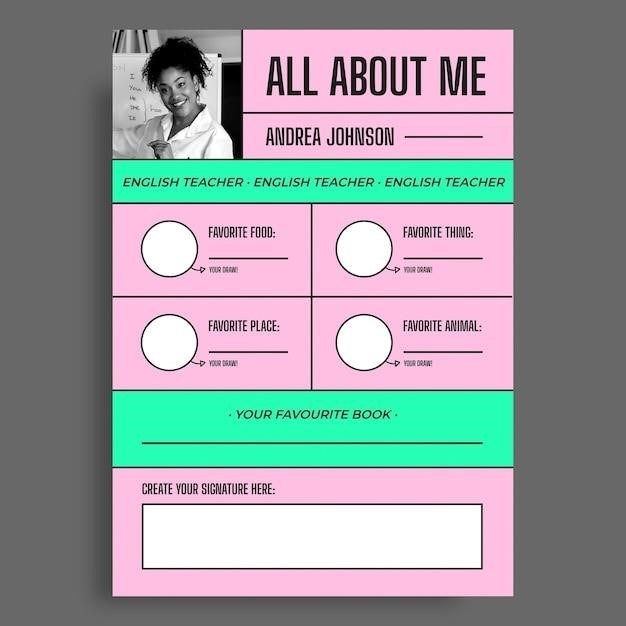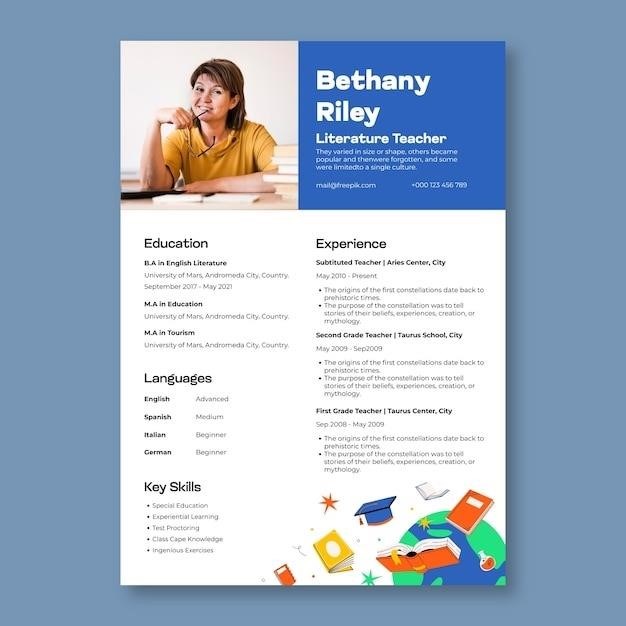
Student Portfolio Examples PDF⁚ A Comprehensive Guide
This guide provides a thorough exploration of student portfolios in PDF format, encompassing their creation, design, and effective use for showcasing academic achievements․ We’ll cover essential components, layout strategies, and the inclusion of reflective statements to maximize impact․ Learn how to compile compelling examples of your best work and present a polished, professional portfolio to potential employers or educational institutions․ Discover practical tips for creating a successful PDF portfolio that effectively highlights your skills and accomplishments․
What is a Student Portfolio?
A student portfolio is a curated collection of academic work, showcasing a student’s skills, knowledge, and growth over time․ It’s more than just a collection of assignments; it’s a purposeful presentation of achievements, reflecting learning processes and outcomes․ Portfolios can be digital or physical, and their contents vary depending on the student’s goals and the context (e․g․, applying to a program, showcasing skills to a potential employer)․ They often include essays, research papers, creative writing pieces, artwork, designs, presentations, and projects․ Crucially, effective portfolios demonstrate not only the finished product but also the process of creation, reflecting critical thinking, problem-solving skills, and self-reflection․ A well-constructed portfolio demonstrates a student’s abilities, highlighting their strengths and areas for improvement․ It provides a comprehensive picture of their capabilities, far exceeding the limitations of a simple grade or transcript․
Types of Student Portfolios
Student portfolios exist in various forms, each serving a unique purpose․ The showcase portfolio highlights a student’s best work, demonstrating their strongest skills and accomplishments․ This type is ideal for applications or showcasing achievements to potential employers․ In contrast, the process portfolio emphasizes the learning journey, documenting the evolution of a project or skill․ It showcases drafts, revisions, and reflections, providing a transparent view of the student’s growth․ A developmental portfolio tracks progress over a longer period, allowing students to see their growth across various courses or projects, ideal for self-assessment and long-term learning․ The problem-solving portfolio focuses on projects that demonstrate the student’s ability to tackle complex challenges, showcasing their analytical and critical-thinking skills․ Finally, the competency-based portfolio directly addresses specific learning objectives or skills, demonstrating proficiency in particular areas․ The choice of portfolio type depends on the student’s goals and the specific information they wish to convey․
Components of a Successful Portfolio
A truly effective student portfolio goes beyond simply compiling work samples; it requires careful planning and execution․ A compelling introduction is crucial, setting the stage and providing context for the included work․ This section should highlight the student’s goals and aspirations, connecting the chosen pieces to a larger narrative․ The portfolio should then present a curated selection of work samples, each chosen strategically to demonstrate specific skills or achievements․ These samples should be high-quality, well-organized, and clearly labeled․ Crucially, each piece should be accompanied by reflective statements, providing insights into the student’s learning process, challenges faced, and lessons learned․ These reflections add depth and demonstrate self-awareness․ Finally, a strong conclusion summarizes the student’s key takeaways and future goals, reinforcing the overall message․ By incorporating these elements, the portfolio becomes a powerful tool for showcasing the student’s abilities and potential․
Examples of Work to Include
The specific content of a student portfolio will vary depending on the field of study and the portfolio’s purpose․ However, some common examples of work to include are⁚ High-quality writing samples, such as essays, research papers, or creative writing pieces, demonstrating strong writing skills and critical thinking․ Artwork and design projects showcasing creativity and technical proficiency, potentially including drawings, paintings, graphic designs, or 3D models․ Projects from science or math courses, such as lab reports, data analysis, or mathematical proofs, illustrating problem-solving skills and scientific reasoning․ Presentations, whether PowerPoint slides or video recordings, highlighting communication skills and the ability to convey complex information effectively․ Any other projects reflecting the student’s skills and accomplishments, such as coding projects, musical compositions, or contributions to group projects, are also valuable inclusions․ Remember to select diverse examples that showcase a range of abilities and achievements․

Digital vs․ Physical Portfolios
The choice between a digital and physical portfolio depends largely on the intended audience and the nature of the work being showcased․ Digital portfolios, often in PDF format, offer advantages such as easy sharing via email or online platforms, convenient accessibility, and the ability to incorporate multimedia elements like videos and interactive presentations․ This format is particularly well-suited for showcasing work that benefits from digital presentation, such as interactive design projects or multimedia presentations․ Physical portfolios, on the other hand, offer a tangible representation of work, potentially making a stronger visual impact, especially for artistic or design-focused portfolios․ They can also be useful when internet access is limited or when the portfolio needs to be presented in person․ Ultimately, the best choice depends on the specific context and the strengths of the work being presented․ Consider your audience and the most effective way to present your accomplishments․
Creating a PDF Portfolio
Creating a professional PDF portfolio involves a strategic approach to assembling and presenting your work․ Begin by carefully selecting the pieces that best represent your skills and achievements․ Ensure high-quality scans or digital versions of your work are used․ Organize your portfolio logically, perhaps chronologically or thematically, to guide the viewer through your progression and accomplishments․ Consider using a consistent design template throughout, incorporating elements such as headings, subheadings, and clear visual hierarchy to improve readability․ Incorporate descriptive captions and brief explanations for each piece to provide context and highlight key skills or learning outcomes․ Proofread meticulously for any errors in grammar, spelling, or formatting․ Once complete, test the PDF on different devices and platforms to ensure consistent viewing and accessibility․ A well-structured and visually appealing PDF portfolio significantly enhances the impact of your work․
Designing an Effective Layout
A well-designed layout is crucial for a compelling student portfolio PDF․ Prioritize clarity and readability; avoid overwhelming the viewer with too much information on a single page․ Use a consistent font and font size throughout, ensuring easy reading across different devices․ Employ a clean and uncluttered design, incorporating ample white space to prevent a cramped feel․ Structure your content logically, using clear headings and subheadings to guide the reader through your work․ Consider using visual cues, such as bullet points, numbered lists, and visual dividers, to enhance organization and break up large blocks of text․ If including images or graphics, ensure they are high-resolution and relevant to the accompanying text․ Maintain consistency in the visual style, using a unified color palette and design elements throughout the document․ A well-structured and visually appealing layout enhances the overall professionalism and impact of your portfolio․
Adding Reflective Statements
Incorporating reflective statements significantly elevates your student portfolio PDF․ These statements demonstrate self-awareness and critical thinking skills, showcasing your ability to analyze your work and learning process․ For each project or piece of work included, write a brief reflection explaining your approach, challenges encountered, and key learnings․ Discuss the skills demonstrated, highlighting your strengths and areas for improvement․ Connect your work to broader concepts and theories learned in your coursework․ Explain how your work reflects your personal growth and development․ Use a conversational yet professional tone, avoiding overly casual language․ These reflective statements provide context and depth to your accomplishments, making your portfolio a more impactful representation of your abilities and potential․ Remember, thoughtful reflection demonstrates a commitment to continuous improvement․
Using Templates and Examples
Leveraging pre-designed templates and examples can streamline the creation of your student portfolio PDF․ Numerous online resources offer customizable templates, providing a structured framework for organizing your content․ Explore various designs to find one that aligns with your personal style and the specific requirements of your intended audience․ Analyzing successful student portfolio examples provides valuable insights into effective presentation strategies․ Observe how others have structured their content, incorporated visuals, and crafted compelling narratives․ Pay attention to the use of whitespace, fonts, and overall aesthetic appeal․ Remember that a well-designed portfolio enhances readability and professionalism․ While templates offer a helpful starting point, personalize your portfolio to reflect your unique skills and experiences․ Don’t be afraid to experiment with different layouts and design elements to create a portfolio that truly represents you․
Showcase Your Best Work
The primary objective of a student portfolio is to highlight your most impressive achievements and skills․ Carefully curate the content to showcase your strongest work, ensuring each piece demonstrates your capabilities effectively․ Prioritize quality over quantity; including fewer, high-impact pieces is more impactful than overwhelming the viewer with numerous mediocre examples․ Consider the context of your portfolio’s intended use․ If applying for a specific job or program, tailor your selection to align with their requirements and preferences․ For example, if applying for a design role, prominently feature your most visually stunning and innovative projects․ If applying for a writing-intensive program, showcase your most polished and insightful writing samples․ Remember to present your work in a clear and concise manner, using high-quality images and formatting․ Each piece should be accompanied by a brief, insightful description that highlights its significance and the skills it demonstrates․ By strategically showcasing your best work, you create a compelling narrative that effectively communicates your abilities and potential․
Assessing Your Portfolio
Before submitting your portfolio, a critical self-assessment is crucial․ Review each piece meticulously, evaluating its effectiveness in showcasing your skills and accomplishments․ Ask yourself⁚ Does each piece clearly demonstrate the skills I want to highlight? Is the presentation clear, concise, and visually appealing? Does the overall narrative effectively communicate my abilities and potential? Seek feedback from trusted mentors, professors, or career counselors․ Their objective perspectives can identify areas for improvement you might have overlooked․ Consider the specific criteria of the recipient – whether a potential employer or admissions committee – and align your self-assessment with their expectations․ Look for inconsistencies in quality, gaps in skill representation, or areas where further explanation might be beneficial․ This iterative process of review and refinement ensures your portfolio is not just a collection of work, but a polished and effective representation of your capabilities․ Addressing weaknesses before submission significantly strengthens your final presentation and maximizes its impact․
Sharing Your Portfolio
Once your portfolio is polished and refined, consider the most effective method for sharing it․ For online applications or digital submissions, a PDF is often preferred for its accessibility and compatibility․ Ensure the PDF is optimized for viewing on various devices and screen sizes, maintaining clear readability and visual appeal․ When emailing your portfolio, use a concise and professional subject line that clearly identifies the content and its purpose․ If sharing a physical copy, opt for high-quality printing on durable paper stock, presenting a professional and polished impression․ When presenting your portfolio in person, be prepared to discuss your work confidently and articulate your accomplishments effectively․ Highlight key projects and explain the skills demonstrated in each piece, connecting them to the specific requirements of the opportunity․ Practice your presentation to ensure a smooth and compelling delivery, allowing your passion and expertise to shine․ Remember, your portfolio serves as a visual representation of your skills and dedication – present it with the utmost care and professionalism․
